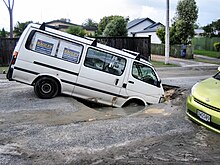Liquefaction
In materials science, liquefaction[1] is a process that generates a liquid from a solid or a gas[2] or that generates a non-liquid phase which behaves in accordance with fluid dynamics.[3] It occurs both naturally and artificially. As an example of the latter, a "major commercial application of liquefaction is the liquefaction of air to allow separation of the constituents, such as oxygen, nitrogen, and the noble gases."[4] Another is the conversion of solid coal into a liquid form usable as a substitute for liquid fuels.[5]
Geology[edit]

In geology, soil liquefaction refers to the process by which water-saturated, unconsolidated sediments are transformed into a substance that acts like a liquid, often in an earthquake.[6] Soil liquefaction was blamed for building collapses in the city of Palu, Indonesia in October 2018.[7]
In a related phenomenon, liquefaction of bulk materials in cargo ships may cause a dangerous shift in the load.[8][9]
Physics and chemistry[edit]
In physics and chemistry, the phase transitions from solid and gas to liquid (melting and condensation, respectively) may be referred to as liquefaction. The melting point (sometimes called liquefaction point) is the temperature and pressure at which a solid becomes a liquid. In commercial and industrial situations, the process of condensing a gas to liquid is sometimes referred to as liquefaction of gases.
Coal[edit]
Coal liquefaction is the production of liquid fuels from coal using a variety of industrial processes.
Dissolution[edit]
Liquefaction is also used in commercial and industrial settings to refer to mechanical dissolution of a solid by mixing, grinding or blending with a liquid.
Food preparation[edit]
In kitchen or laboratory settings, solids may be chopped into smaller parts sometimes in combination with a liquid, for example in food preparation or laboratory use. This may be done with a blender, or liquidiser in British English.
Irradiation[edit]
Liquefaction of silica and silicate glasses occurs on electron beam irradiation of nanosized samples in the column of transmission electron microscope.[10][11]
Biology[edit]
In biology, liquefaction often involves organic tissue turning into a more liquid-like state. For example, liquefactive necrosis in pathology,[12] or liquefaction as a parameter in semen analysis.[13]
See also[edit]
References[edit]
- ^ Some authors contend that there is a distinction between liquefaction and liquification (which is more commonly considered a misspelling), with the latter term applying only to processes involving heat. Knox, Ray; Stewart, David (1995). "3. Recognizing Seismic Landforms". The New Madrid Fault Finders Guide. Marble Hill, MO: Gutenberg-Richter Publications. p. 36. ISBN 978-0-934426-42-8. LCCN 91-91374.
- ^ "Pharmaceutical Processes: Processes of Liquefaction". The Pharmaceutical Era. No. 21. 20 April 1899. p. 503.
[by] a process of liquefaction is meant any process the effect of which is to cause a solid or gaseous body to assume or pass into the liquid state.
- ^ Pickett, Joseph P., ed. (2005). "Liquefaction". The American Heritage Science Dictionary. Boston, MA: Houghton Mifflin Company. p. 363. ISBN 978-0-618-45504-1. LCCN 2004019696.
- ^ Mavrikis, Peter; Horobin, Wendy, eds. (2003). "Liquefaction". How It Works: Science and Technology. Vol. 20 (3rd ed.). Tarrytown, NY: Marshall Cavendish. p. 64. ISBN 0-7614-7314-9. LCCN 2001028771.
- ^ Speight, James G. (2013). The Chemistry and Technology of Coal. Chemical Industries. Vol. 132 (3rd ed.). Boca Raton, FL: CRC Press. pp. 545–607. ISBN 9781138199224.
- ^ USGS. "About Liquefaction". Archived from the original on 2013-04-12.
- ^ Davis, Nicola. "Indonesia earthquake: soil liquefaction blamed for building collapses". The Guardian.
- ^ Gourvenec, Susan (2 September 2018). "Mystery of the cargo ships that sink when their cargo suddenly liquefies". Ars Technica. Retrieved 6 September 2018.
- ^ Marcolini, Barbara; Koettl, Christoph. "How the Indonesia Earthquake Made Soil Flow Like Water". NYT. No. International.
- ^ Möbus, Günter; Ojovan, Michael; Cook, Stuart; Tsai, Jim; Yang, Guang (January 2010). "Nano-scale quasi-melting of alkali-borosilicate glasses under electron irradiation". Journal of Nuclear Materials. 396 (2–3): 264–271. Bibcode:2010JNuM..396..264M. doi:10.1016/j.jnucmat.2009.11.020.
- ^ Zheng, Kun; Wang, Chengcai; Cheng, Yong-Qiang; Yue, Yonghai; Han, Xiaodong; Zhang, Ze; Shan, Zhiwei; Mao, Scott X; Ye, Miaomiao; Yin, Yadong; Ma, Evan (December 2010). "Electron-beam-assisted superplastic shaping of nanoscale amorphous silica". Nature Communications. 1 (1): 24. Bibcode:2010NatCo...1...24Z. doi:10.1038/ncomms1021. ISSN 2041-1723. PMC 3047011. PMID 20975693.
- ^ Robbins and Cotran: Pathologic Basis of Disease, 8th Ed. 2010. Pg. 15
- ^ Gardner, Kavid (2001). Textbook of Assisted Reproductive Technology Laboratory and Clinical Perspectives. Taylor and Francis. p. 63. ISBN 9780415448949. Archived from the original on 2014-01-02. Retrieved 2013-11-03.
